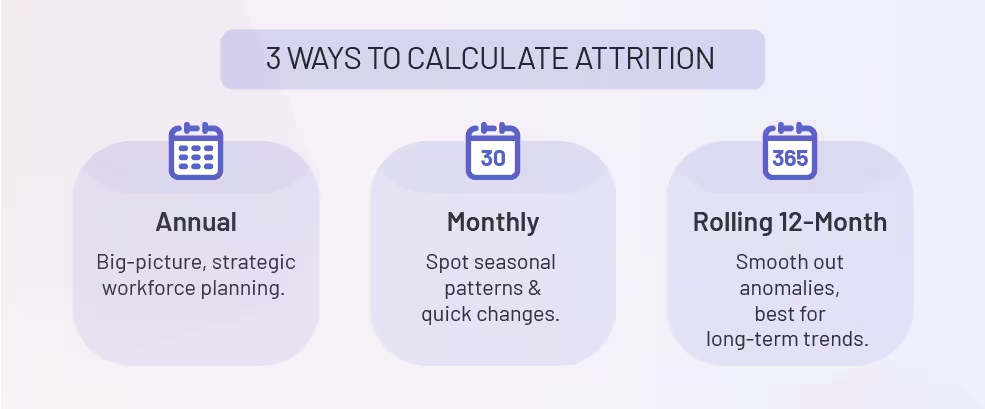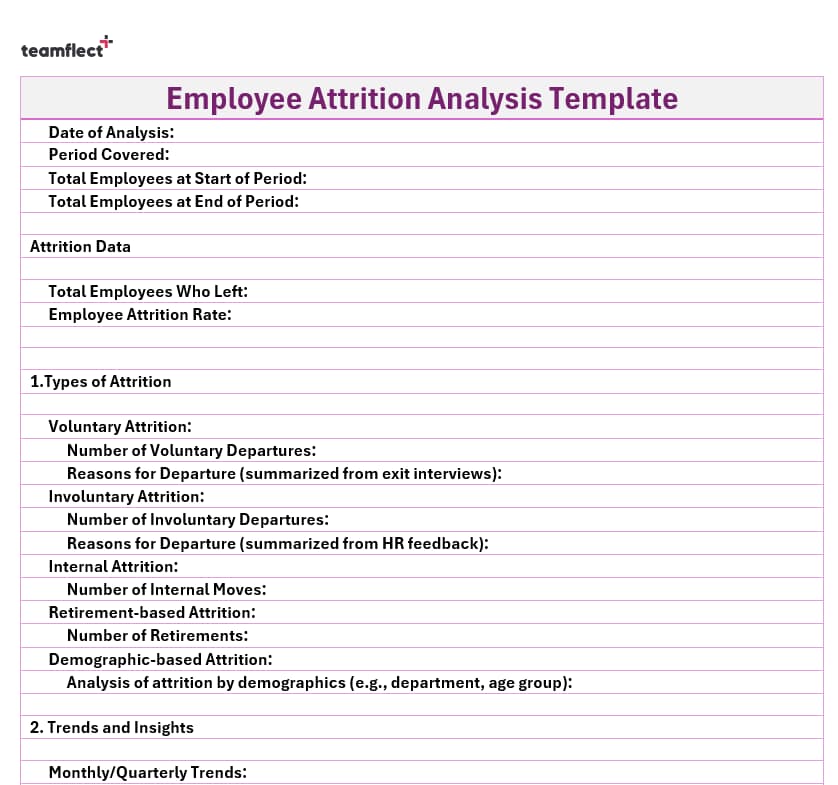Get the Ebook
.svg)
Employee attrition rate is a key metric for understanding workforce dynamics and monitoring turnover.
According to Gallup, replacing an employee can cost 50% to 200% of their annual salary, a conservative estimate. It highlights the importance of tracking attrition to address its root causes effectively. Accurate calculation and analysis of attrition rates allow businesses to develop effective workforce planning and retention strategies, proactively address talent gaps, and maintain operational stability.
Knowing this, we created this article to provide a comprehensive resource on employee attrition rate, guiding HR teams through the calculation process, interpretation of results, and comparison against industry benchmarks.
Employee attrition rate is calculated by dividing total departures by average employee count and multiplying by 100. Unlike employee turnover rate, attrition focuses on workforce reduction rather than replacement.
Access our free, interactive calculator designed specifically for HR professionals. Simply input your departure data and employee counts to get instant attrition rate calculations along with industry comparison insights.
You can use the calculator for different time periods. It also gives you background information to understand the results in various cases.
Attrition rate calculations vary depending on the time period and specific workforce insights needed. Each formula serves different analytical purposes for HR teams tracking workforce changes.

The annual attrition rate formula provides the most comprehensive view of workforce changes over a full business cycle.
Formula: Attrition Rate = (Number of Departures / Average Employee Count) × 100
Step-by-Step Calculation:
Monthly attrition rates help identify immediate patterns and seasonal variations in employee departures.
Monthly Rate = (Monthly Departures / Average Monthly Headcount) × 100
Monthly tracking becomes particularly valuable when implementing employee experience strategy changes that require quick feedback on effectiveness.
The rolling 12-month calculation provides the most accurate trending data by smoothing out seasonal anomalies and short-term fluctuations.
Formula: Sum of 12 months departures ÷ Average of 12 months headcount × 100
This method proves most effective for performance management reporting and strategic workforce planning decisions.
According to SHRM, a generally desired employee attrition rate is below 10%, signaling a stable and healthy workforce. However, they also mentioned that acceptable rates may vary across industries due to factors like:
Industries such as technology, retail, and hospitality tend to have higher employee turnover. On the other hand, the healthcare, finance, and government sectors generally strive for lower turnover.
HR professionals should use industry benchmarks as guides. They should always consider the unique organizational context when setting goals. It’s also a good practice to identify warning signs early.
We summarized this in the table below, highlighting the typical attrition rates per industry and the key considerations for each.
If your rate of attrition is above 10%, it can be regarded as a high attrition rate, indicating that a significant portion of employees is leaving.
Simply put, a high attrition rate means that an organization is having a tough time keeping its employees around, and this challenge impacts everyone involved.
Let’s get into details and see what causes high attrition and how it affects organizations.
Understanding the causes of high attrition is the first step to prevent the workforce churn and increase staff retention rate.
Not establishing a work environment where employees feel supported and satisfied is among the reasons that cause high attrition. According to Mercer’s 2024 Global Talent Trends, employees seek workplaces that practice employee empowerment and allow them to be their authentic selves.
In the competitive landscape, a lack of financial stability leads to high attrition and makes up most of voluntary employee and new hire turnover. Employees today are looking for more than just a monthly paycheck; they seek a long-term financial relationship with their organization in exchange for their labor. One way to reduce voluntary attrition is to keep up with and even set new industry standards.
Another cause of the high employee attrition rate is the lack of career development opportunities.
To foster a meaningful reciprocal relationship, organizations should offer career development plans and resources that help employees thrive and to help you with it, you can use start by using our employee development plan template!
On the contrary, if employees feel that their organization is not investing in their growth and long-term success, they can turn into disengaged employees, leading to attrition.
Organizations that push for a high-performance culture without considering work-life balance are setting themselves up for high attrition.
When the pressure is relentless and boundaries blur, employees can quickly show burnout signs and feel undervalued.
To reduce the causes of high attrition and avoid the consequences, organizations need to embrace a proactive approach to increase satisfaction and engagement in employees.
Keep in mind that strategies to manage employee attrition aren’t limited to what’s listed below. Every organization has its own unique culture, and taking the time to analyze it can lead to fresh, effective strategies that truly resonate with your team.
Listening to your employees is crucial in developing strategies to prevent turnover. Organizations should aim to understand how their employees feel during their tenure. Incorporating employee engagement surveys into the workflow is an effective way to gain insights and reduce high attrition rates.
Think of career pathing as a roadmap for your team. It’s about aligning their aspirations with the opportunities your organization offers.
When employees understand how they can progress, whether through vertical moves, lateral shifts, or even cross-functional roles, they feel a sense of direction and purpose. In short, if you invest in your employees’ futures, they’re much more likely to stay and invest in your organization’s success which is a powerful way to tackle high attrition rates.
Having a positive, people centric culture is one of the most cost-effective way to reduce attrition rates. But what does that really mean?
A people-centric culture prioritizes healthy communication, empathy, and respect at every level of the organization. When employees feel valued and heard, they're more likely to stay engaged and committed to their roles.
Big companies like Google, Microsoft, and Patagonia exemplify this approach, showcasing how a people-centric culture can lead to high employee loyalty and satisfaction!
To retain talent, make sure your compensation packages are not just good but truly competitive and this goes beyond just a paycheck, think about health insurance, retirement plans, and flexible work arrangements that cater to modern needs and expectations.
Regularly benchmarking your offerings against industry standards can keep you ahead of the curve and reduce employee attrition rates.

At Teamflect, we’re passionate about sharing insights. Download our employee attrition analysis template to get a clearer view of how your organization is managing turnover!
Employee Attrition Analysis Template
Wrapping up, keeping track of your employee attrition rates is a must for the continuity of organizational health and success. Building lasting relationships with your team begins with creating a positive workplace where everyone feels supported and satisfied. Let’s make that a priority!
Attrition occurs when employees leave and positions remain unfilled or are eliminated. Meanwhile, turnover involves replacing departing employees. Attrition typically shows workforce reduction. Turnover suggests ongoing recruitment and replacement activities.
A 20% attrition rate may be acceptable in high-turnover industries like retail. However, it can be concerning in stable sectors like financial services. Context matters more than the absolute number. Compare your rate against industry benchmarks and historical organizational data for accurate assessment.
Calculate attrition rates monthly for operational insights and annually for strategic planning. Rolling 12-month calculations provide the most reliable trending data. Quarterly reviews help balance operational responsiveness with strategic perspective.
An all-in-one performance management tool for Microsoft Teams
